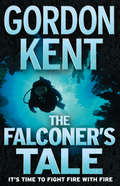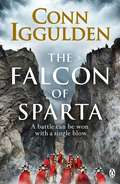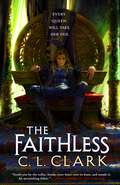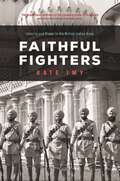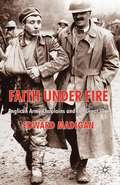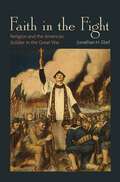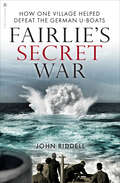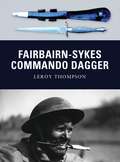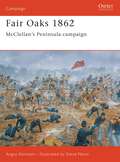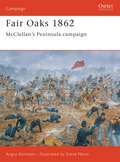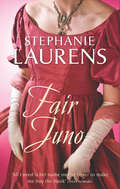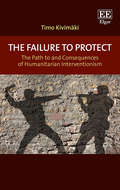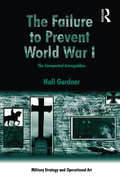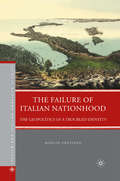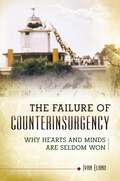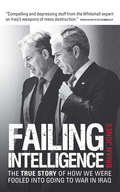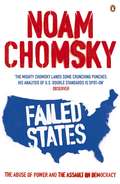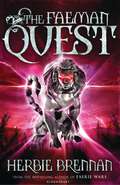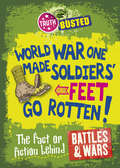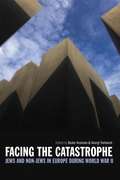- Table View
- List View
The Falconer’s Tale
by Gordon KentAn exhilarating new tale of modern espionage and international intrigue – sure to appeal to the many fans of Tom Clancy, Dale Brown and Patrick Robinson.
The Falcon of Sparta: The gripping and battle-scarred adventure from The Sunday Times bestselling author of Empire
by Conn IgguldenTHE GRIPPING ADVENTURE BASED ON AN EPIC TRUE STORY FROM THE BESTSELLING AUTHOR, PERFECT FOR FANS OF BERNARD CORNWELL 'HIS FINEST NOVEL TO DATE . . . THE BATTLE SCENES ARE THRILLING' SUNDAY EXPRESS __________ In the Ancient World, one army was feared above all others. 401 BC. The Persian king Artaxerxes rules an empire stretching from the Aegean to northern India. As many as fifty million people are his subjects. His rule is absolute. But the sons of Sparta are eager to play the game of thrones . . . Battles can be won - or lost - with a single blow. Princes fall. And when the dust of civil war settles, the Spartans are left stranded in the heart of an enemy's empire, without support, without food and without water. Far from home, surrounded by foes, it falls to the young soldier Xenophon to lead the survivors against Artaxerxes' legendary Persian warriors . . . __________ 'The pace is nail-biting' THE TIMESPraise for Conn Iggulden:'Here is a master at work. There is no one better at this' GILES KRISTIAN'Brings war in the ancient world to vivid, gritty and bloody life. I'm blown away' ANTHONY RICHES'Iggulden tells an absolutely cracking story...the pace is nail-biting and the set dressing magnificent' THE TIMES'An epic piece of historical fiction, full of political intrigue and vivid action' ROBERT FABBRI'Iggulden is in a class of his own when it comes to epic, historical fiction' DAILY MIRRORAuthor's novel, Empire was a Sunday Times bestseller May 2023
The Faithless: Magic of the Lost, Book 2 (Magic of the Lost #2)
by C. L. ClarkThe rebels have won, and the empire is withdrawing from Qazal. But undoing the tangled web that binds the two nations will not be easy, and Touraine and Luca will face their greatest challenge yet.Luca needs to oust her uncle from the Balladairan throne once and for all and take her rightful place as Queen. But he won't let go of power so easily. When he calls for a 'Trial of Competence' and Luca's allies start disappearing from her side, she will need to find a way to prove her might. And she knows someone who can help. . .Touraine has found a home in the newly free country of Qazal. But she soon realizes that leading a country and leading a revolution are two very different tasks. And, even more importantly, if Luca's uncle doesn't ratify the treaty, the Qazali could end up right back where they started. Together, the two women will have to overcome their enemies, their history, and their heartbreak in order to find a way to secure Luca's power and Touraine's freedom.
Faithful Fighters: Identity and Power in the British Army
by Kate ImyDuring the first four decades of the twentieth century, the British Indian Army projected an illusion of racial and religious inclusivity. The army recruited diverse soldiers, called 'Martial Races,' including British Christians, Punjabi Sikhs, Hindu Rajputs, Muslims from northwestern India and Afghanistan, and 'Gurkhas' from Nepal. They incorporated some of these soldiers' traditions into the army to keep them disciplined and loyal. This included allowing Muslims to fast during Ramzan, mandating purification ceremonies for Nepali Hindus, and enabling Sikhs to carry religious swords. Military officials hoped that bringing these practices into the army would undermine criticisms of imperial military service within communities where anti-colonial sentiment grew stronger. Instead, as Faithful Fighters shows, it created unintended dialogues between soldiers and civilians while hardening differences between and among communities. Though the illusion of soldiers' detachment from anticolonialism crumbled during World War II, Kate Imy argues that the army militarized racial and religious difference, creating lasting legacies for the violent partition and independence of India, and the endemic violence of the postcolonial world. Faithful Fightersreceived the NACBS Stansky prize and the Pacific Coast Branch Book Award of the American Historical Association.
Faith Under Fire: Anglican Army Chaplains and the Great War
by Edward MadiganAfter the Great War some texts by British Army veterans portrayed the Anglican chaplains who had served with them in an extremely negative light. This book examines the realities of Anglican chaplains' wartime experiences and presents a compelling picture of what it meant to be a clergyman-in-uniform in the most devastating war in modern history.
Faith in the Fight: Religion and the American Soldier in the Great War
by Jonathan H. EbelFaith in the Fight tells a story of religion, soldiering, suffering, and death in the Great War. Recovering the thoughts and experiences of American troops, nurses, and aid workers through their letters, diaries, and memoirs, Jonathan Ebel describes how religion--primarily Christianity--encouraged these young men and women to fight and die, sustained them through war's chaos, and shaped their responses to the war's aftermath. The book reveals the surprising frequency with which Americans who fought viewed the war as a religious challenge that could lead to individual and national redemption. Believing in a "Christianity of the sword," these Americans responded to the war by reasserting their religious faith and proclaiming America God-chosen and righteous in its mission. And while the war sometimes challenged these beliefs, it did not fundamentally alter them. Revising the conventional view that the war was universally disillusioning, Faith in the Fight argues that the war in fact strengthened the religious beliefs of the Americans who fought, and that it helped spark a religiously charged revival of many prewar orthodoxies during a postwar period marked by race riots, labor wars, communist witch hunts, and gender struggles. For many Americans, Ebel argues, the postwar period was actually one of "reillusionment." Demonstrating the deep connections between Christianity and Americans' experience of the First World War, Faith in the Fight encourages us to examine the religious dimensions of America's wars, past and present, and to work toward a deeper understanding of religion and violence in American history.
Faith in the Fight: Religion and the American Soldier in the Great War
by Jonathan H. EbelFaith in the Fight tells a story of religion, soldiering, suffering, and death in the Great War. Recovering the thoughts and experiences of American troops, nurses, and aid workers through their letters, diaries, and memoirs, Jonathan Ebel describes how religion--primarily Christianity--encouraged these young men and women to fight and die, sustained them through war's chaos, and shaped their responses to the war's aftermath. The book reveals the surprising frequency with which Americans who fought viewed the war as a religious challenge that could lead to individual and national redemption. Believing in a "Christianity of the sword," these Americans responded to the war by reasserting their religious faith and proclaiming America God-chosen and righteous in its mission. And while the war sometimes challenged these beliefs, it did not fundamentally alter them. Revising the conventional view that the war was universally disillusioning, Faith in the Fight argues that the war in fact strengthened the religious beliefs of the Americans who fought, and that it helped spark a religiously charged revival of many prewar orthodoxies during a postwar period marked by race riots, labor wars, communist witch hunts, and gender struggles. For many Americans, Ebel argues, the postwar period was actually one of "reillusionment." Demonstrating the deep connections between Christianity and Americans' experience of the First World War, Faith in the Fight encourages us to examine the religious dimensions of America's wars, past and present, and to work toward a deeper understanding of religion and violence in American history.
Fairlie’s Secret War: How One Village Helped Defeat German U-Boats
by John RiddellDuring the Second World War the Royal Navy’s vitally important Anti-submarine Experimental Establishment was secretly moved from Portland in Dorset to the Ayrshire village of Fairlie, to escape German bombing on the south coast. For the next six years it occupied the boatyard of yacht builder William Fife on the Firth of Clyde. During this time, highly confidential world-leading research on the acoustic detection of submarines by asdic – now known as sonar – was carried out by hundreds of scientists, officers and local men and women based at Fairlie. As experiments took place into new ways of sinking German U-boats, the peace of the quiet village was shattered. Winston Churchill described the work done at Fairlie as critical to winning the Battle of the Atlantic and ultimately the war. The research remained relevant to anti-submarine warfare long after the war, and is still relevant today.Fairlie’s role in the war was not disclosed until relatively recently. Highly illustrated throughout and making use of previously unpublished material, this book tells the full story of the establishment at Fairlie for the first time. It describes the impact it had on local people, and their relationship with the naval officers and scientists who came to work there.
Fairbairn-Sykes Commando Dagger (Weapon)
by Howard Gerrard Leroy ThompsonThe Fairbairn-Sykes Commando dagger has become iconic as the most widely recognized fighting knife in the world. The origins of the dagger can be traced to Shanghai in the 1930s where W. E. Fairbairn and US Marine officers including Sam Yeaton carried out experiments to develop what they considered the perfect knife for close combat. When Fairbairn and Sykes became instructors for the Commandos, they refined the design which would evolve into the classic Fairbairn-Sykes dagger. The dagger was first used during early Commando raids into occupied Europe but saw action in every theatre of World War II. US Rangers and Marines who had trained with the Commandos took their Fairbairn-Sykes daggers home, and this also influenced the development of American Special Forces daggers. The Fairbairn-Sykes remained in use with many units after the war. It has become a symbol of Commando and special forces units throughout the world.
Fairbairn-Sykes Commando Dagger: The Complete Illustrated History Of The Fairbairn-sykes Fighting Knife (Weapon #7)
by Howard Gerrard Leroy ThompsonThe Fairbairn-Sykes Commando dagger has become iconic as the most widely recognized fighting knife in the world. The origins of the dagger can be traced to Shanghai in the 1930s where W. E. Fairbairn and US Marine officers including Sam Yeaton carried out experiments to develop what they considered the perfect knife for close combat. When Fairbairn and Sykes became instructors for the Commandos, they refined the design which would evolve into the classic Fairbairn-Sykes dagger. The dagger was first used during early Commando raids into occupied Europe but saw action in every theatre of World War II. US Rangers and Marines who had trained with the Commandos took their Fairbairn-Sykes daggers home, and this also influenced the development of American Special Forces daggers. The Fairbairn-Sykes remained in use with many units after the war. It has become a symbol of Commando and special forces units throughout the world.
Fair Oaks 1862: McClellan’s Peninsula campaign (Campaign)
by Angus KonstamFollowing its humiliating defeat at the First Battle of Bull Run, General George B. McClellan took command of the Union Army of the Potomac. In the spring of 1862, having rebuilt his forces, the "Little Napoleon" devised a plan to end the war in a single campaign. Transporting his army by sea to the Virginia Peninsula, he would outflank Confederate forces and march unopposed on Richmond, the Southern capital. Excessive caution squandered the opportunity, however, and on 31 May the Confederates struck at McClellan's divided forces at Fair Oaks. This book details McClellan's controversial Peninsula campaign and the southern attempt to halt the Union juggernaut.
Fair Oaks 1862: McClellan’s Peninsula campaign (Campaign)
by Angus KonstamFollowing its humiliating defeat at the First Battle of Bull Run, General George B. McClellan took command of the Union Army of the Potomac. In the spring of 1862, having rebuilt his forces, the "Little Napoleon" devised a plan to end the war in a single campaign. Transporting his army by sea to the Virginia Peninsula, he would outflank Confederate forces and march unopposed on Richmond, the Southern capital. Excessive caution squandered the opportunity, however, and on 31 May the Confederates struck at McClellan's divided forces at Fair Oaks. This book details McClellan's controversial Peninsula campaign and the southern attempt to halt the Union juggernaut.
Fair Juno (Mira Ser. #No. 13)
by Stephanie LaurensFrom the sparkling ballrooms of Regency London to the wealthy glamour of the country house – let Stephanie Laurens be your guide!
The Failure to Protect: The Path to and Consequences of Humanitarian Interventionism
by Timo KivimäkiThis book investigates the reasons behind, and consequences of, military operations by Western powers. It focuses on those humanitarian interventions aimed at protecting civilians from terror, dictators and criminals in fragile states. Contributing to the cosmopolitan, feminist and post-colonial literature on interventions, 12 case studies from across the globe are explored, including military interventions in: Afghanistan, the Central African Republic, Iraq, Kosovo, Libya, Mali, Mauritania, Pakistan, Sierra Leone, Somalia, Syria and Yemen. The interventionist era post 1999 has been associated with an increase in conflict fatalities, while the non-interventionist era 1989–1999 is associated with declining conflict violence. This book analyses both quantitatively and qualitatively the interactive discourses of the proponents and opponents of humanitarian protection. Timo Kivimäki explores the need for a representative global agency and legitimate institutions to avoid accusations of partisanship, and calls for the removal of the masculine gender bias in protection to create ‘democratic matriotism’. A timely read for advanced international relations scholars, this book analyses the data surrounding military interventions, providing a thorough insight into the last two decades of humanitarian conflict work. Politicians and practitioners of wartime humanitarian protection will also greatly benefit from this book.
The Failure to Prevent World War I: The Unexpected Armageddon (Military Strategy and Operational Art)
by Hall GardnerWorld War I represents one of the most studied, yet least understood, systemic conflicts in modern history. At the time, it was a major power war that was largely unexpected. This book refines and expands points made in the author’s earlier work on the failure to prevent World War I. It provides an alternative viewpoint to the thesis of Christopher Clark, Fritz Fischer, Paul Kennedy, among others, as to the war's long-term origins. By starting its analysis with the causes and consequences of the 1870-71 Franco-Prussian War and the German annexation of Alsace-Lorraine, the study systematically explores the key geostrategic, political-economic and socio-cultural-ideological disputes between France, Germany, Austria-Hungary, Italy, Russia, Japan, the United States and Great Britain, the nature of their foreign policy goals, alliance formations, arms rivalries, as well as the dynamics of the diplomatic process, so as to better explain the deeper roots of the 'Great War'. The book concludes with a discussion of the war's relevance and the diplomatic failure to forge a possible Anglo-German-French alliance, while pointing out how it took a second world war to realize Victor Hugo’s nineteenth-century vision of a United States of Europe-a vision now being challenged by financial crisis and Russia's annexation of Crimea.
The Failure to Prevent World War I: The Unexpected Armageddon (Military Strategy and Operational Art)
by Hall GardnerWorld War I represents one of the most studied, yet least understood, systemic conflicts in modern history. At the time, it was a major power war that was largely unexpected. This book refines and expands points made in the author’s earlier work on the failure to prevent World War I. It provides an alternative viewpoint to the thesis of Christopher Clark, Fritz Fischer, Paul Kennedy, among others, as to the war's long-term origins. By starting its analysis with the causes and consequences of the 1870-71 Franco-Prussian War and the German annexation of Alsace-Lorraine, the study systematically explores the key geostrategic, political-economic and socio-cultural-ideological disputes between France, Germany, Austria-Hungary, Italy, Russia, Japan, the United States and Great Britain, the nature of their foreign policy goals, alliance formations, arms rivalries, as well as the dynamics of the diplomatic process, so as to better explain the deeper roots of the 'Great War'. The book concludes with a discussion of the war's relevance and the diplomatic failure to forge a possible Anglo-German-French alliance, while pointing out how it took a second world war to realize Victor Hugo’s nineteenth-century vision of a United States of Europe-a vision now being challenged by financial crisis and Russia's annexation of Crimea.
The Failure of Italian Nationhood: The Geopolitics of a Troubled Identity (Italian and Italian American Studies)
by M. GrazianoThis book explains Italy s endless political instability and its historical, cultural and economic roots. It also illustrates why, even after the creation of the Italian state, Italy was never really unified. Piero Gobetti described fascism once as the "autobiography" of the Italian nation. This book explains why today it is possible to describe "berlusconism" - a cultural, political and social phenomenon in Italy- as the most recent version of this country s autobiography.
The Failure of Counterinsurgency: Why Hearts and Minds Are Seldom Won (Praeger Security International)
by Ivan ElandThis book examines the implications of counterinsurgency warfare for U.S. defense policy and makes the compelling argument that the United States' default position on counterinsurgency wars should be to avoid them.Given the unsatisfactory outcomes of the counterinsurgency (COIN) wars in Afghanistan and Iraq, the U.S. military is now in a heated debate over whether wars involving COIN operations are worth fighting. This book provides a comprehensive analysis of the effectiveness of COIN through key historic episodes and concludes that the answer is an emphatic "no," based on a dominant record of U.S. military or political failure, and inconsistency in the reasons for the rare cases of success. The author also examines the implications of his findings for U.S. foreign policy, defense policy, and future weapons procurement.
The Failure of Counterinsurgency: Why Hearts and Minds Are Seldom Won (Praeger Security International)
by Ivan ElandThis book examines the implications of counterinsurgency warfare for U.S. defense policy and makes the compelling argument that the United States' default position on counterinsurgency wars should be to avoid them.Given the unsatisfactory outcomes of the counterinsurgency (COIN) wars in Afghanistan and Iraq, the U.S. military is now in a heated debate over whether wars involving COIN operations are worth fighting. This book provides a comprehensive analysis of the effectiveness of COIN through key historic episodes and concludes that the answer is an emphatic "no," based on a dominant record of U.S. military or political failure, and inconsistency in the reasons for the rare cases of success. The author also examines the implications of his findings for U.S. foreign policy, defense policy, and future weapons procurement.
Failing Intelligence: How Blair Led Us into War in Iraq
by Brian JonesThis is the first book on Iraq by a British intelligence official involved in the process that led to Britain taking part in the 2003 invasion. As the former head of the UK Defence Intelligence Staff's nuclear, biological and chemical section, Brian Jones is ideally placed to pronounce upon the way in which Britain was taken to war and the way in which the intelligence reporting on Iraq's weapons of mass destruction (WMD) was manipulated to justify Saddam Hussein's removal from power. Jones calls on his own experience and knowledge, a variety of leaked documents, and the expert testimony given to a series of inquiries, including the current Chilcot inquiry, to examine how and why Tony Blair and George W. Bush, managed to deceive their legislatures and their electorates into believing that Iraqi WMD was a real threat that could attack the West within 45 minutes. He describes how Blair and Bush sought to use subsequent inquiries to cover up their own culpability in the deception, in order to facilitate re-election and keep their jobs. In conclusion, Jones pulls together the lessons that should have been learned in relation to both the use of intelligence to justify policy-making and with regard to broader international issues of security and governance.
Failed States: The Abuse of Power and the Assault on Democracy (American Empire Project Ser.)
by Noam ChomskyThe United States asserts the right to use military force against ‘failed states’ around the globe. But as Noam Chomsky argues in this devastating analysis, America shares features with many of the regimes it insists are failing and constitute a danger to their neighbours. Offering a comprehensive and radical examination of America past and present, Chomsky shows how this lone superpower – which topples foreign governments, invades states that threaten its interests and imposes sanctions on regimes it opposes – has stretched its own democratic institutions to breaking point. And how an America in crisis places the world ever closer to the brink of nuclear and environmental disaster.
The Faeman Quest (Faerie Wars Chronicles)
by Herbie BrennanIn the exciting conclusion to Herbie Brennan's New York Times bestselling Faerie Wars series, a child who is half faerie, half human has the power to determine the fate of both worlds.The Faeman Girl is Mella, daughter of Lord Henry and Queen Holly Blue, half faerie, half human and all trouble. When Mella accidentally travels to the country of Haleklind, she discovers rebel forces preparing an invasion using magical manticores. Old favourites are here - Brimstone, Lord Hairstreak and Pyrgus - but readers will identify immediately with Mella, whose stubborn streak and feisty daring must save the faerie realm from mass destruction.
The Fact or Fiction Behind Battles and Wars: The Fact Or Fiction Behind Battles And Wars (Truth or Busted #12)
by Kay BarnhamTruth or Busted's battles and wars title explores popular myths and legends about some of the world's most famous conflicts in a tongue-in-cheek, humorous way that kids will find unputdownable! Alongside features such as 'Battle Blunders' in which we learn about people or countries that have lost battles or wars for bizarre reasons, Truth or Busted statements such as 'Ancient Greek armies were square' or 'Elephants are excellent warriors' are explored. We look at where the idea came from, whether it has any basis in truth, or whether they can be consigned to folklore. Finally, each statement is given a TRUTH or BUSTED evaluation! A must for anyone interested in battles and wars, or studying history at school!
Facing the Catastrophe: Jews and Non-Jews in Europe during World War II (Occupation in Europe)
by Beate Kosmala Georgi VerbeeckCovering Western and Eastern Europe, this book looks at the Holocaust on the local level. It compares and contrasts the behaviour and attitude of neighbours in the face of the Holocaust. Topics covered include deportation programmes, relations between Jews and Gentiles, violence against Jews, perceptions of Jewish persecution, and reports of the Holocaust in the Jewish and non-Jewish press.
Facing the Catastrophe: Jews and Non-Jews in Europe during World War II (Occupation in Europe)
by Beate Kosmala Georgi VerbeeckCovering Western and Eastern Europe, this book looks at the Holocaust on the local level. It compares and contrasts the behaviour and attitude of neighbours in the face of the Holocaust. Topics covered include deportation programmes, relations between Jews and Gentiles, violence against Jews, perceptions of Jewish persecution, and reports of the Holocaust in the Jewish and non-Jewish press.
